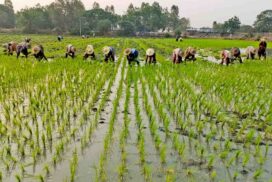
In Ayeyawady Region, paddy trade has been normal, and farmers have enjoyed profits of at least K400,000 and even about K1 million per acre, according to the Ayeyawady Region Rice Millers Association.
There are buyers in the market, and the price has been steady. The trade has been typical this year, unlike previous years. At that time, the price plunged when farmers sold their paddy rampantly, he said.
“There are buyers who buy paddy sensibly. In the past, when farmers sold in a rush, prices plunged down. This year, the price has been steady, and the trade has been normal. Paddy quality has become different between the beginning of harvest and now. In Pathein, paddy fields, in which saltwater flows, have declined in its quality, and the price of such non-premium paddy is K1.8-K2 million per 100 baskets,” said the association’s official.
Including agricultural costs, it costs about K800,000 an acre to grow summer paddy, and the yield is 60-70 baskets an acre. Under the current market price, farmers can make at least around K400,000 an acre and some who grow the New Ayeyar variety, whose yield is higher, enjoy around K1 million profit per acre.
“The expenditure for growing summer paddy is approximately K800,000 an acre, including agricultural cost. So, let’s say the production is 60-70 baskets an acre. The farmer will receive K1.2 million if he can produce 60 baskets, so K400,000 will be left if he uses K800,000. If the price is K1.8 million, he will receive more than K1.1 million and more than 300,000 will be surplus. Some farmers who dare to take risks grow New Ayeyar so that it can yield around 120-130 baskets an acre. If the yield is 120 baskets, they will receive K2.4 million and can make about K1 million profit. They can make a profit, too, if it is calculated at K1.8 million. So it is cost-effective for farmers,” he said.
Moreover, farmers don’t need to use fertilizer during the rainy season like summer paddy, so the cost will be reduced, and they will be better.
“Rain-fed paddy is more cost-effective. In the monsoon season, the water rises and drops, and silt will be left, so fertilizers are not much needed, reducing the cost. If it reduces the cost for a fertilizer bag, the expenditure will be low, about K100,000 and will be better for farmers,” he said. — MT/ZS/ED















